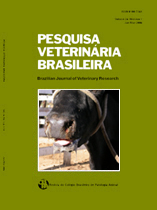 |
|
|
|
Year 2007 - Volume 27, Number 07
|

|
Intoxicação experimental por Senecio brasiliensis (Asteraceae) em eqüinos, p.287-296
|
ABSTRACT.- Pilati C. & Barros C.S.L. 2007. [Experimental poisoning by Senecio brasiliensis (Asteraceae) in horses.] Intoxicação experimental por Senecio brasiliensis (Asteraceae) em eqüinos. Pesquisa Veterinária Brasileira 27(7):287-296. Departamento de Patologia, Universidade Federal de Santa Maria, 97105-900 Santa Maria, RS, Brazil. E-mail: claudioslbarros@uol.com.br
Fourteen 4 to 22-year-old mixed breed horses weighing 230-475 kg were experimentally fed the dried aerial parts of Senecio brasiliensis (Spreng.) collected in its sprouting stage. A 15-year-old horse served as non-plant-fed control. Small amounts of the dried plant material were admixed in the ration given to the horses; larger amounts were grounded, admixed with water and force fed through nasogastric intubation. Liver biopsies were periodically performed in 11 horses. Nine horses died with signs or lesions of the poisoning after having received amounts of the plant corresponding to 0.87%, 1.5% (single administrations), 1.74% (two weekly administrations), 3.0% (three daily administrations), 7.42% (17 weekly administrations), 8.9% (284 daily administrations), 9.66% (82 daily administrations) and 9.30% (43 weekly administrations) of their body weight. Two horses which received amounts of the plant corresponding to 15.0% (30 and 60 daily administrations) of their body weight died during the experiments due to unrelated causes. Three horses which received amounts of the plant corresponding to 0.5% and 1.0% (single administrations), and 15.0% (240 daily administrations) of their body weight, and the control horse survived without any clinical signs. The disease induced by the plant had a clinical course of 1-30 days and was characterized by anorexia, jaundice and neurological signs of hepatic encephalopathy. Weight loss was observed in the more protracted cases. Necropsy findings included marked enhancement of the lobular pattern of the livers or those were firm and dark-red. Hemorrhages were frequent and more conspicuous on the subcutis, serosal surfaces and in the gastrointestinal mucosa. Edema occurred in the submucosa of the gastrointestinal tract and in body cavities. Histologically, the livers of horses that ingested relatively larger amounts of the plant for short periods of time had zonal coagulative necrosis and centrilobular to massive hemorrhages. Moderate to marked hepatomegalocytosis and mild to moderate fibrosis were seen in 4 horses which ingested small amounts of the plant for longer periods. Cholestasis and hemosiderosis were observed in the liver of 8 horses, neutrophilic aggregates in 6 and acidophilic intranuclear pseudo-inclusion bodies in hepatocytes of 3 horses. Changes suggestive of hepatic encephalopathy were observed in the brain of 6 horses. The earliest detected change in the liver biopsies was vacuolization of hepatocyte nuclei followed by apoptotic loss of hepatocytes, hepatomegalocytosis, infiltration of neutrophils and centrolobular necrosis. Occasionally hepatocellular acidophilic intranuclear pseudo-inclusion bodies and, in more protracted cases, slight fibrosis were seen. No changes were observed in the liver biopsies of the 3 plant-fed horses that survived, nor on the 2 horses that died of unrelated causes. The control horse had no clinical signs. |
| |
|
|
| |
|
 |